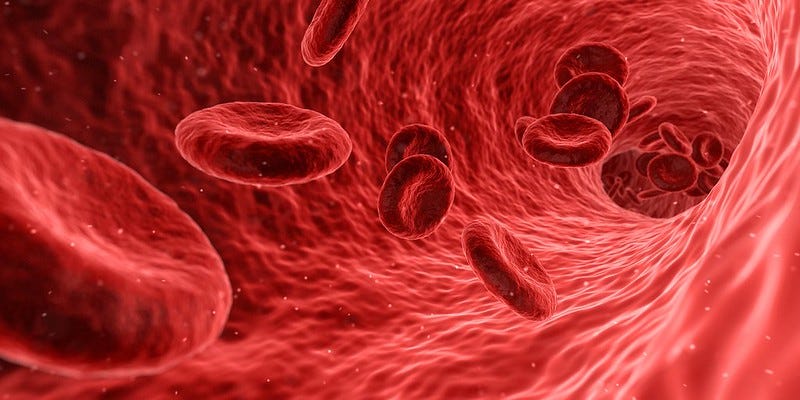
Red blood cells (RBCs) are the most numerous type of cell in the blood. They contain hemoglobin proteins which allow them to bind oxygen and transport it around the body.
Shape
RBCs have a particular shape. Imagine a donut, but the donut doesn’t exactly have a hole, it’s just thinner in the middle. This shape is called ‘biconcave discoid’ because it’s like a disc where both sides are concave (curved inwards).
This particular shape gives RBCs a high surface area, which is important. Whether a RBC is picking up oxygen from the lungs, or releasing oxygen to tissues, the oxygen needs to pass across the RBC’s membrane, and this is more likely to happen if the membrane has as much surface area as possible.
Deformability
RBCs are highly deformable (squishy). They have to be, because blood sometimes has to flow through vessels that are narrower than the width of a single RBC, and the cells have to squish to get through.
In 2018 a group of researchers found that the RBCs of people with ME (the illness sometimes known as Myalgic Encephalomyelitis, Chronic Fatigue Syndrome, or ME/CFS) are less deformable than usual. This is a big deal - it’s a good guess that, because of these less-deformable blood cells, the blood of people with ME moves more slowly through microcapillaries (the tiny, porous blood vessels where RBCs deliver oxygen and nutrients to cells and carry away carbon dioxide and other waste). This would lead to hypoxia (not enough oxygen) and a build-up of waste products, which might (wholly or partly) explain the symptoms of extreme fatigue, exertional intolerance, and post-exertional malaise.
What causes the red blood cells of people with ME/CFS to be less deformable?
It’s probably oxidative stress. The squishiness of RBCs depends on the cells having a specific set of proteins in their membranes. If these membrane proteins are damaged by oxidants, the cells lose their squishiness.
Ongoing research
As far as I can tell there’s only one research group looking at the deformability of RBCs in people with ME, with two papers, published in 2018 and 2019, and a Master’s thesis due to come out in August. The Open Medicine Foundation has a page on their website suggesting that they are looking at this - I’m not sure if that’s the same research group or a different one.
References and further reading
Red blood cell deformability is diminished in patients with Chronic Fatigue Syndrome (2019)
Erythrocyte Deformability As a Potential Biomarker for Chronic Fatigue Syndrome (2018, abstract only)
The Deformability of Red Blood Cells in Myalgic Encephalomyelitis/Chronic Fatigue Syndrome (ME/CFS) (2022, Master’s thesis, abstract only)
Red Blood Cell Deformability in ME/CFS - A brief description of ongoing research by the Open Medicine Foundation.
The ME/CFS platelet hyperactivation + blood clotting analysis - A brief description of an ongoing study at polybio.org.
MEA Summary Review: Red blood cells in ME/CFS demonstrate reduced ability to change shape


